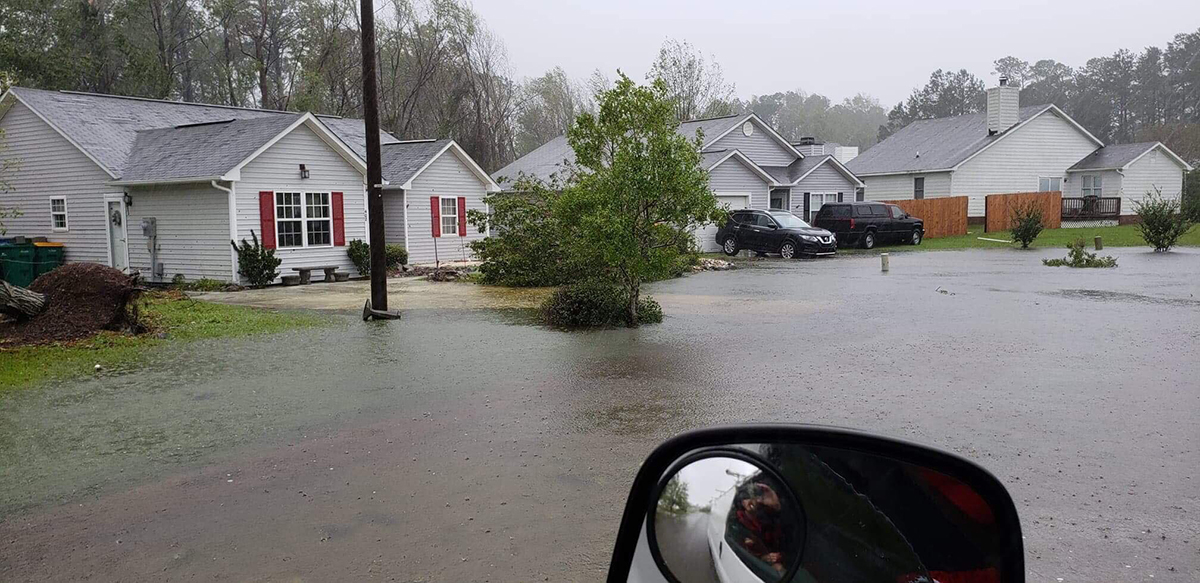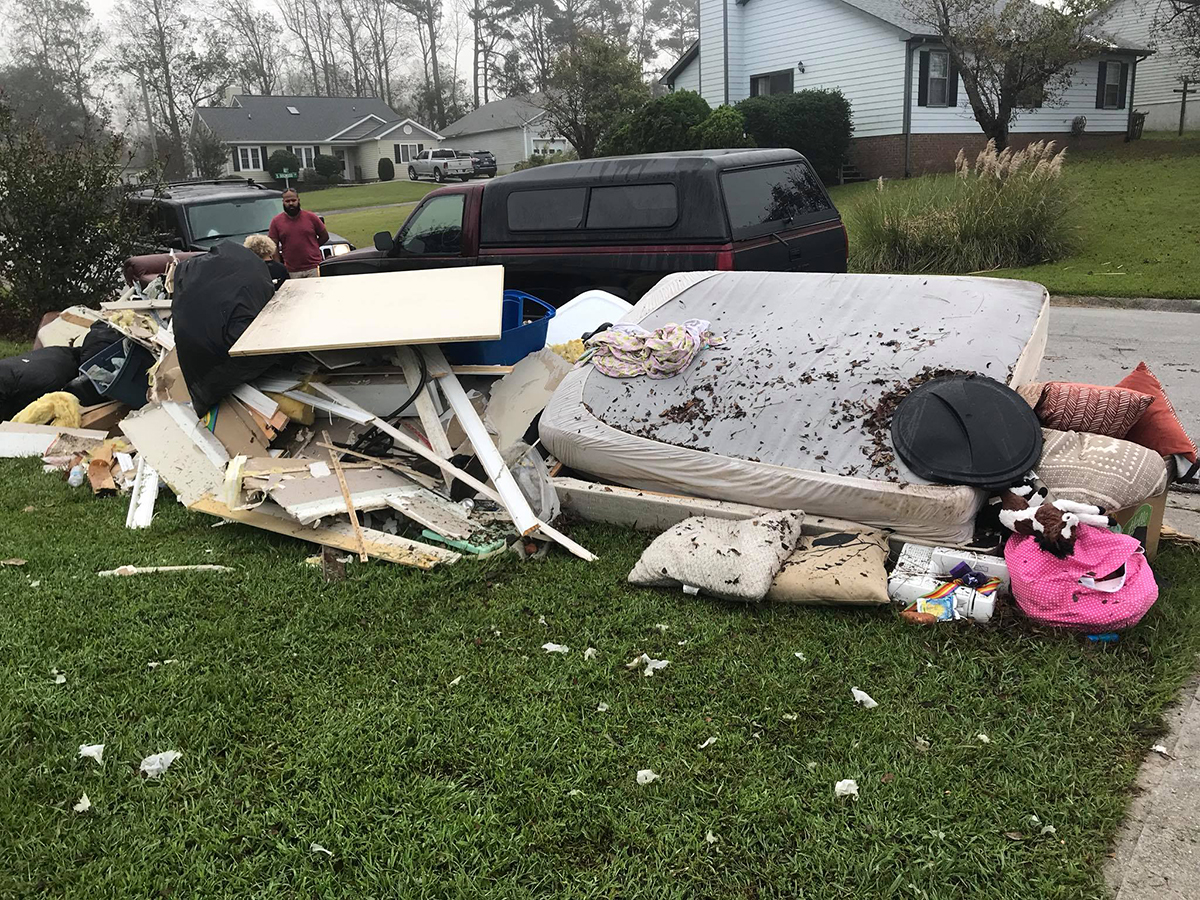
Zena Underwood and her husband Mark bought in October 2011 what they thought was the perfect house for their young family on Holly Lane in Swansboro.
Not long after the first-time homeowners moved into the four-bedroom, single-story house at the bottom of a hill next to a creek, they learned from their neighbors that there was a history of repeat flooding.
Supporter Spotlight
“After the first time it flooded with us there, we had neighbors show us photos of cars parked in the street in front of our house with water up to the windows,” Underwood, a 36-year-old business owner and mother of two, recently told Coastal Review. “I was so upset. We were stuck, too — young, doing OK, but certainly not in a position to buy another house, or to keep fixing the one we were in over and over. Flood insurance was just too expensive. Also, (we) found out the neighbor had so many claims that their flood insurance provider dropped them.”
Now in a different home on higher ground, the Underwoods got relief through a state-funded program managed by the North Carolina Office of State Budget and Management’s disaster recovery section, although that help didn’t come until more than a year after Hurricane Florence in 2018 had severely damaged their home and destroyed belongings and after yet another flood in 2019.
As a result of Florence, everything in the house below 2 feet high had to be ripped out and tossed — drywall, flooring, furniture, cabinets, personal belongings. Demolition revealed a cracked foundation. Sinkholes formed in the yard.
Marcia Evans, communications specialist with the Office of State Budget and Management, told Coastal Review that the Underwoods qualified for the state assistance because, in addition to the damage sustained during Hurricane Florence, the property was subject to recurring flooding and Onslow County had recommended the family for assistance.
The State Acquisition and Relocation Fund, or SARF, provides relocation assistance up to $50,000 for homeowners whose primary residence has been approved for buyout under the state 2018 Disaster Recovery Act. To qualify, buyout homes must be in a flood-prone area where elevation is not feasible or where acquisition of the structure would minimize flood risks or support stormwater mitigation. The State Emergency Management Act part 6 addresses emergency assistance funds and the governor’s authority to set up programs to distribute them.
Supporter Spotlight
Underwood told Coastal Review that she and her husband heard about the program after reaching out to town officials in Swansboro, local media and officials at the state level, “trying to get someone to help. Someone to look, see that the drainage was not working, or something was not right. There was just nowhere for runoff water to go and more and more neighborhoods kept going in. It was only going to get worse over time.”
The couple attended a meeting with other Onslow County residents, including their next-door neighbor, whose home had also flooded repeatedly. Families were presented with the options of assistance for relocation, elevating the house or repairs for homes that could be fixed and had no record of flooding before Hurricane Florence. The Underwoods selected relocation assistance.
Before being awarded the SARF funds, Underwood had penned a letter to the Office of State Budget and Management pleading for help. She explained that what attracted them to their house was the neighborhood, which was close to the schools and had lots of children around. She had a son who was just beginning to walk when they bought the home. A few years later, they welcomed a baby girl.
“We could see our little family here. Again, we were young, excited and inexperienced. We didn’t research the address, talk to neighbors about the history, etc. We made them an offer and they accepted. We are NOT in a flood zone. This is an important note. We did not have flood insurance,” she wrote.
First signs of a problem
After moving into the house and experiencing a few thunderstorms, the Underwoods began to see signs of a problem. Often, they would have to park up the street and wade through deep water to get home.
“Once I got a call from my husband at work telling me I should park at the top of the hill when I got home, and there would probably be water in the living room. He was right. That was the first time we had to replace the floors. Again, not in a flood zone. No flood insurance,” Underwood wrote.
There were two other rainstorms that brought water to their front door, and “then we had Hurricane Florence. We flooded again, with no flood insurance. And no huge nest egg of savings, so we were faced with two options. Walk away from the house, take the hit as a foreclosure and walk away, lose everything we had worked for. Or just fix it, again,” she said, adding that the damage was worse than ever. The walls, cabinets, furniture, beds, toys, clothes, appliances – all ruined.

With two kids, five pets and a business based in their home – Underwood owns her own event consulting and florals business — they didn’t have a choice but to fix it.
Then during summer 2019, they experienced flooding again, this time during a thunderstorm. Floodwater reached the front door in under an hour.
Underwood wrote that when a came letter later that year asking her family to attend a meeting, they jumped at the opportunity.
“We need this. This home needs to be demolished. As sad as that makes me to say, the millions of memories we have made here, I still believe that no house should be here. It will continue to flood. This drainage issue can’t be fixed adequately until they can dig under where we are. They recently came out to check the drain and discovered a very large sinkhole. Right beside my driveway, where my kids have played for years. The ground is literally washing away around our home,” she wrote.
The family was notified by the Office of State Budget and Management in December 2019 that they were preapproved for SARF housing support for up to $50,000, because the residence was to be purchased by the county or state for hazard mitigation related to the recovery efforts from Hurricane Florence.
In a vote taken Feb. 17, 2020, Onslow County commissioners signed off on the purchases of Underwood’s home and her neighbor’s. The county received funding from North Carolina Emergency Management in 2019 through the Disaster Recovery Act of 2018. The funding was made available to property owners not eligible for federal recovery programs that also met certain income and residency requirements, according to the meeting minutes.
Jessica Rhue, director of planning and development for Onslow County, told the board at the time that county staff had been working with the Office of State Budget and Management for six months on coordinating the buyouts. With county commissioners’ approval, the Underwoods’ home became town property and cannot be redeveloped.
Evans told Coastal Review that the Office of State Budget and Management works closely with Department of Public Safety’s Division of Emergency Management, or NCEM.
The state, through the Office of State Budget and Management Disaster Recovery Section, put out the invitation for bid in late December 2019 to demolish the Underwood home and two others on behalf of Onslow County, pursuant to a disaster recovery grant NCEM awarded the county for housing recovery.
The land has since been cleared.
Within six months of the commissioners’ meeting, a few people had come to take photos and perform an appraisal, an offer was presented and accepted, and the family had moved out.
“It was a nice and easy process and the representative that was assigned to help us has been so patient and helpful,” Underwood said. “We drove by recently and noticed the two sinkholes have grown since we left. One was right under our son’s room, the other — the large one — was next to the driveway.”
Underwood said that her family wasn’t ready to buy a new house so quickly and options were few, so the state extended the buyout assistance payout portion for them until the end of 2020.
“Then there were no homes available in Onslow County that met the criteria — we can’t be in a floodplain. Then COVID, so it was extended again. We are hoping to finish it all up at the end of this year,” she said.
Phillip Smith, senior project manager with the disaster recovery division, explained in an interview last week that the program that helped the Underwoods was for those who suffered flooding damage from hurricanes.
“When we buy out a property, they of course have to find a new place to live, and we also require that new place to be outside of a flood zone,” so they don’t get flooded again, he said. Land that is flood-free is usually more expensive than property that floods frequently. So, the program provides up to $50,000 to make the difference in land values.
“When we buy a property, we have it appraised – what we call a retrospective appraisal — and we’ll go back and figure out the value of the property prior to the hurricane before any flood damage. So they’re getting the value of their property before the hurricane and then we offer the $50,000 on top of that funding,” he said.
For example, if the buyout property is appraised at $150,000, the homeowner would get that $150,000 and SARF will provide up to $50,000 to cover the difference for their next home.
Smith explained that the flood maps have been revised since hurricanes Matthew and Florence because those were such unusually devastating storms that the flood maps weren’t accurate.
“Zena was getting flooded — she lived at the bottom of the hill next to a creek — after every rainstorm,” Smith said, adding the water from the neighborhood above her was funneling to her house and a sinkhole was developing between her and her neighbor’s house.
Smith said that since the SARF program deals mostly with primary residences, much of the work has been from riverine flooding in interior counties, rather than vacation homes on the immediate coast.
Although there are similarities between the state program that helped the Underwoods and others like ReBuild NC, there are differences. State Acquisition and Relocation Fund monies are dispersed through the Office of State Budget and Management while ReBuild NC, which as its name indicates is a rebuilding program, falls under the Department of Public Safety. ReBuild NC also has access to SARF but the funds are used differently.
Also, ReBuild NC primarily uses federal funds. Generally, state funds have less red tape, so Smith’s office can respond to families that don’t fit into federal programs. “To work with our group, you can’t qualify for federal,” he said.
Smith added that at the time, the Underwoods’ home was not designated as part of the 100-year floodplain, “that’s one of the big distinctions between where we can help. Federal can only help within the 100-year floodplain.”
Smith added that the program through the Office of State Budget and Management has helped 50 families relocate and has helped more than 400 families with repairs, elevation and reconstruction.
“I think it does so much good. We encounter a lot of situations where people have had their homes destroyed or have been enduring regular flooding, and it just don’t make sense to keep repairing them over and over,” he said, adding there’s not too many places where you can get a grant like this to be somewhere safe and free from flooding.
Underwood encourages anyone who finds themselves in a situation like hers to reach out to their town’s planning and zoning officials.
“Be the squeaky wheel. Sometimes plans need to change and be modified over the years to accommodate growth and development within communities. Go to the meetings, get the contact, send emails. Take pictures, post online. Keep pushing for someone to listen and take notice of a problem,” she said.







